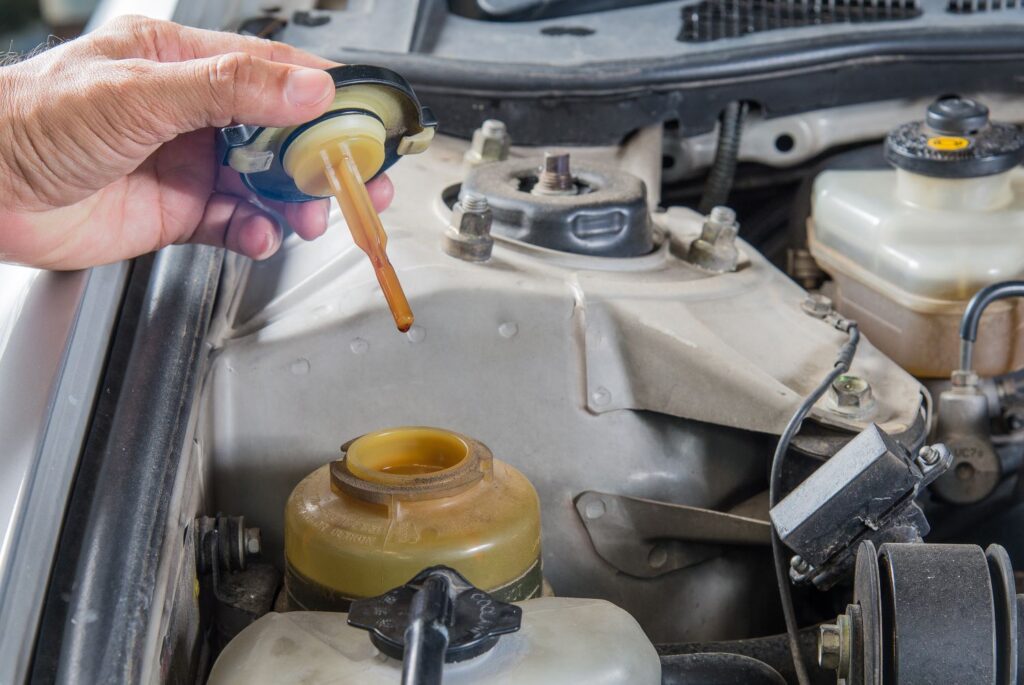Power steering fluid can change color over time. Much like a mood ring, its color can usually hint at the problems your vehicle’s power steering system is experiencing. If you’re wondering what color your power steering fluid is, then the answer will depend on how your vehicle is doing.
What Is the Color of Power Steering Fluid?
The most common colors of fresh power steering fluid are red and very light brown, but it isn’t the only color you’ll find on the market. Some manufacturers use clear or pink power steering fluid. In European vehicles, it’s green sometimes. This is likely to help you differentiate between it and automatic transmission fluid (ATF), which is also usually red and better to use in some Ford vehicles.
The two most common types of power steering fluid are red and a very light brown color. In European vehicles, it is green sometimes.
–Anthony Harlin, ASE Certified Master Automobile Technician
What Causes Power Steering Fluid to Change Color?
Opening up a fresh gallon of power steering fluid and comparing it to the fluid from a vehicle that’s been on the road for years will make it easy to see differences in smell, consistency, and color. But what exactly causes these changes? Here are some common culprits:

Metal Shavings
Notice any gray or silver streaks in your power steering fluid? You’re most likely seeing metal shavings from a failing power steering pump.
Over time, power steering fluid can break down and fail to lubricate the parts of your steering system, causing them to grind against each other. As they do, they produce metal shavings that fall into the power steering fluid and contaminate it.
Water
Moisture and power steering fluid should never mix, but there might be times when water finds its way into your steering system and turns your power steering fluid into a foamy or milky color. Sometimes, it also results from air entering the system.
Foamy or milky power steering fluid is a lost cause. The trapped moisture or air will turn it slimy, compromising its ability to power your steering system. If this happens to you, you’ll have to completely drain your steering system and start over with a fresh batch of power steering fluid.
Coolant Leak
Power steering fluid doesn’t usually turn yellow. If the fluid in your power steering reservoir has turned yellow, it’s likely someone accidentally poured coolant into the power steering system. While this shouldn’t affect your power steering that much, you should probably worry about your engine instead. If the coolant doesn’t stop leaking, you might end up with an overheating engine.

Fluid Degradation
Black or brown power steering fluid means it’s well past its prime. Over time, your power steering fluid will break down and turn dirty from all the debris and dirt that manages to find its way into your steering system. You don’t have to panic if your power steering fluid has turned black or brown, but it is a sign that you need to have it flushed as soon as possible.
What To Do if Your Power Steering Fluid Is Black
There’s no going back from black power steering fluid. The only solution now is to completely drain your power steering system and refill it with fresh fluid.
Flushing your power steering system can be a messy, complicated process, but you can always hire a mechanic to do it for you. However, if you don’t mind getting your hands a bit greasy, then you can also do it yourself.

Other Power Steering Fluid FAQ
What Is Power Steering Fluid?
Your power steering pump makes it easier for you to steer your vehicle, but it can only do so with the help of the power steering fluid. Every time you turn the steering wheel, your pump uses power steering fluid to apply pressure to your power steering system and turn your front wheels in your desired direction.
The power steering fluid also acts as a lubricant to prevent parts of your steering system from grinding against each other, making sure the valves, pistons, and pump all function properly.
How Long Does Power Steering Fluid Last?
Power steering fluid can last a long time, but it needs to be flushed and replaced at regular intervals. Most manufacturers recommend replacing your power steering fluid around 40,000 to 80,000 miles. Of course, this can still vary depending on your vehicle’s make, model, and several other factors.
Can You Drive Without Power Steering Fluid?
Even if you can still drive your vehicle without power steering fluid, it doesn’t actually mean you should. It can get difficult to drive without the help of the power steering system. This can prove to be a difficult task, especially when you’re driving at slow speeds.
You’re also very likely to do unrepairable damage to your power steering pump and steering gear.
How Many Liters of Power Steering Fluid Do You Need?
Not having enough power steering fluid can harm your vehicle, but having too much power steering fluid is no good either. Most vehicles only need around one to two quarts of power steering fluid. Going above that can cause a leak, with power steering fluid finding its way into systems it shouldn’t be in, like your engine bay.
Power steering fluid constantly rises and lowers, so having too much fluid will just overflow out of the reservoir due to not having any room for expansion.
Any information provided on this Website is for informational purposes only and is not intended to replace consultation with a professional mechanic. The accuracy and timeliness of the information may change from the time of publication.






























